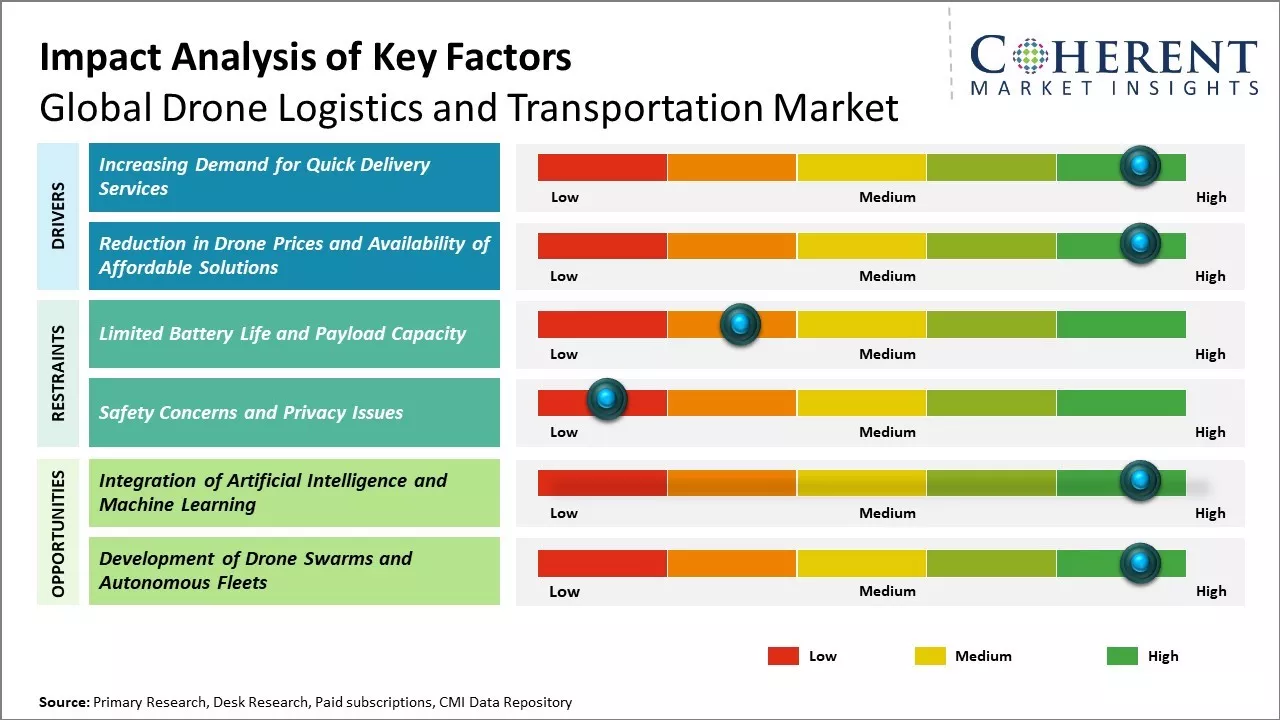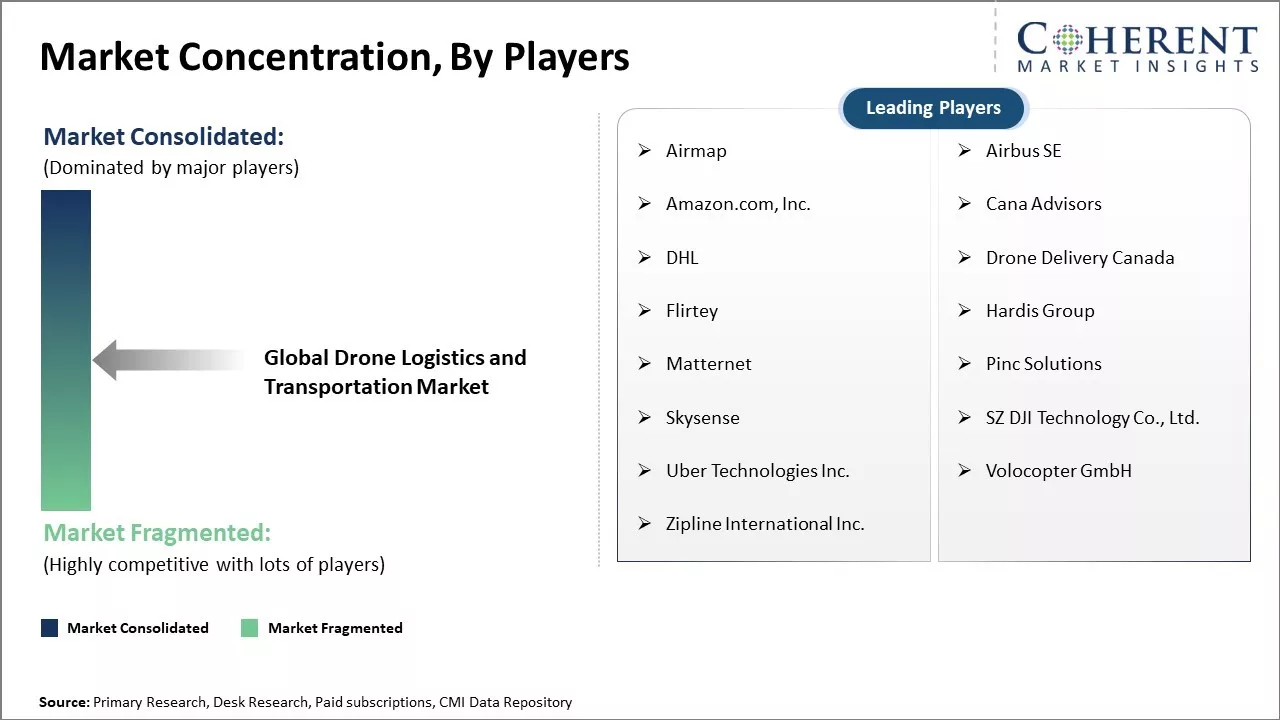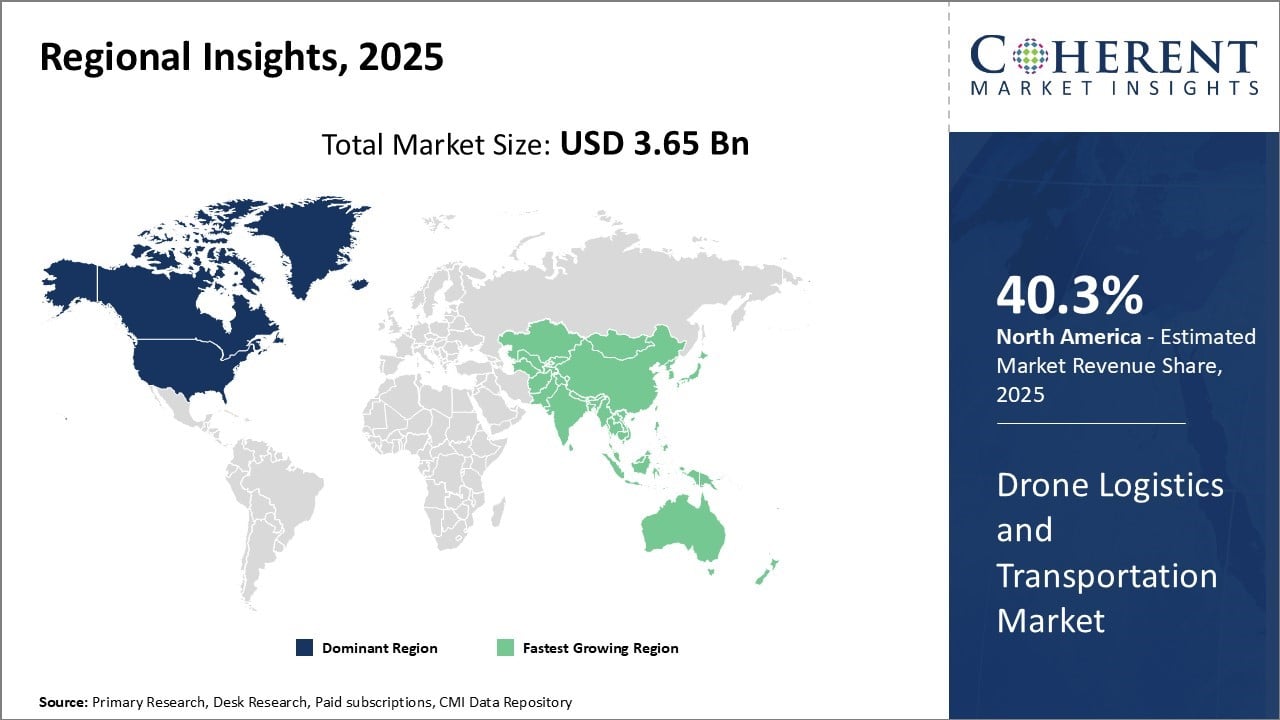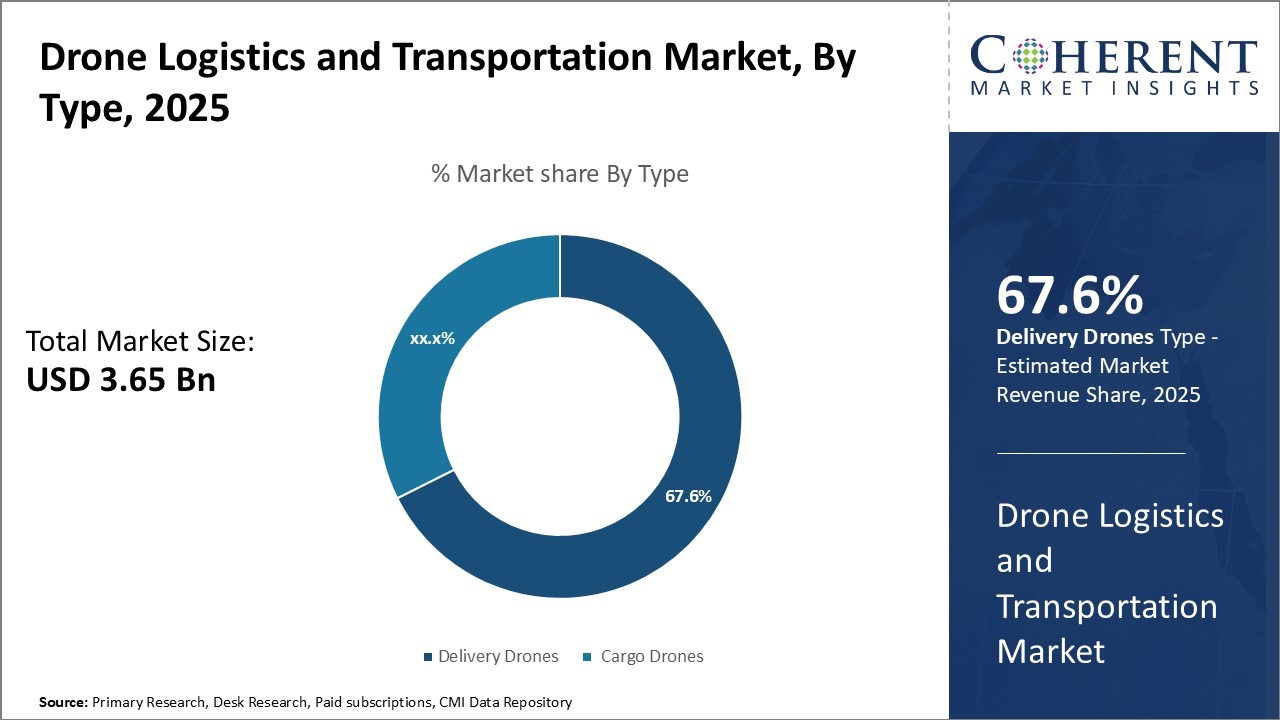Global Drone Logistics and Transportation Market Size and Share Analysis
Global drone logistics and transportation market is estimated to be valued at USD 3.65 Bn in 2025 and is expected to reach USD 12.78 Bn by 2032, exhibiting a compound annual growth rate (CAGR) of 19.6% from 2025 to 2032.

To learn more about this report, Download Free Sample
Key Takeaways
- In terms of Type, Delivery Drones’ Segment is estimated to contribute the highest market share of 67.6% in 2025.
- In terms of Range, the Medium Range (25 to 100km) segment is expected to contribute the largest market share of 52% in 2025.
- In terms of Application, E-Commerce Segment is estimated to contribute the highest market share of 43.2% in 2025.
- North America dominates the global drone logistics and transportation market with an estimated market share of 40.3% in 2025.
Market Overview
There has been increase in usage of drones for transportation as it helps to transport goods in hard-to-reach or disaster-struck areas in very less time. It is more efficient and economical than traditional modes of transportation. Major e-commerce players are investing heavily in research and development of drones to explore their potential in last-mile deliveries. Several test deliveries of packages have been successful, indicating wide opportunities for drones in logistics. Advancements in artificial intelligence, autonomous flying capabilities, and increased payload capacities can boost adoption of drones for transportation applications.
Current Events and Its Impact on Drone Logistics and Transportation Market
|
Current Events |
Description and its impact |
|
Meituan Expands China Urban Drone Delivery
|
|
|
Walmart & Wing Scale Drone Deliveries in the U.S.
|
|
Uncover macros and micros vetted on 75+ parameters: Get instant access to report
Pricing Analysis of Drone Logistics and Transportation Market
The market pricing of the drone logistics and transport market is influenced by several factors including type of drone (cargo, delivery, surveillance), payload, range, autonomy level, software integration, and regulatory allowances. Prices vary significantly depending on whether the use case is last-mile delivery, industrial logistics, or emergency supply dropping.
Lower-range delivery drones for short-range, light payloads (below 5 kg) typically fall in the range of $5,000 to $15,000 per unit. Startups and small-scale operators use these most frequently for e-commerce, food delivery, etc. Middle-tier commercial drones, offering more range (up to 40 km), autonomous, and weather-resistance features, could cost anywhere from $20,000 to $50,000. These are used in large-scale logistics applications such as the transportation of medical goods or intra-city parcel delivery.
Heavy-lift or heavy-capacity drones that can carry up to 200 kg for industrial or military applications are well over $100,000, not including infrastructure and support systems. AI and real-time data analysis-capable software and fleet management platforms are part of the cost. Subscription to the platforms will range from $500 to $5,000 per month based on fleet size and capabilities.
Operational costs, such as maintenance, battery replacement, insurance, regulatory certification, and specialized labor for flight operations or monitoring, account significantly for the overall cost of drone logistics service. However, companies such as Amazon, Wing, and Zipline are pushing economies of scale, progressively reducing per-delivery costs, which are days ago put at $3 to $10 per package, similar to traditional last-mile logistics.
Market Concentration and Competitive Landscape

To learn more about this report, Download Free Sample
Drone Logistics and Transportation Market Insights, By Type
In terms of type, delivery drones’ segment is estimated to contribute the highest market share of 67.6% in 2025, owing to their ability to efficiently transport a wide variety of goods. Delivery drones are optimized for hauling parcels, packages, food orders and medical supplies directly to customers or end users. Their automated last-mile delivery capabilities address growing expectations for fast and convenient shipping options.
Growth of e-commerce growth has boosted demand as online retailers increasingly utilize drones to provide same-day or same-hour delivery services. Healthcare industry also boosts demand for delivery drones as these aircraft help to get critical medical supplies like medications, blood, defibrillators and first aid kits to patients much faster than road-based transportation. Their autonomous delivery potential is highly valuable for emergency response situations.
Food delivery has emerged as a substantial new application as well with dozens of startups pioneering drone-enabled options for quickly transporting prepared meals and grocery items to customers. The versatility of delivery drones in serving diverse logistics needs across multiple economic sectors drives their prominent role in the market.
Drone Logistics and Transportation Market Insights, By Range
In terms of range, medium range (25 to 100km) segment is estimated to contribute the highest market share of 52% in 2025, due to their optimal performance profile for many cargo transport jobs. Their range makes medium drones highly practical for routine distribution routes and various other applications within supply chain networks.
Short range drones are limited to smaller localized payloads under 5kg for missions within 25km, restricting their use mainly to low-weight internal delivery needs. Long range drones covering over 100km have greater heavy-lift capability for large and consolidated cargo but require more advanced technologies like modular battery packs for extended flight times. These also tend to be significantly larger and more expensive than medium range models.
For most commercial cargo transport needs, medium range drones offer the right balance of payload weight, distance capability and cost-effectiveness. As various industries implement drone logistics on expanding scales, these traits will sustain medium range aircraft as the leading cargo drone platform.
Drone Logistics and Transportation Market Insights, By Application
In terms of application, e-commerce segment is estimated to contribute the highest market share of 43.2% in 2025, due to growing volumes of parcels requiring fast, economical delivery. The massive growth in e-commerce packages flows is stretching traditional ground-based delivery infrastructure to its limits.
Drones have emerged as a means to relieve pressure on overburdened last-mile carriers like UPS, FedEx and local postal services. Their automated delivery capabilities offer a way for retailers to provide significantly speedier shipping options competitive with in-store shopping experiences. Pioneering e-tailers like Amazon, Walmart and Target have already trialed drone delivery programs to explore using these aircraft to ferry packages the last one to two miles to customers’ doorsteps. Reducing delivery times from days down to hours or minutes provides online merchants a substantial edge in meeting customer expectations.
Regional Insights

To learn more about this report, Download Free Sample
North America Drone Logistics and Transportation Market Analysis and Trends
North America dominates the global drone logistics and transportation market with an estimated market share of 40.3% in 2025. The region is home to major drone operators as well as drone technology developers. Several U.S.-based companies such as UPS, FedEx, and Amazon are actively testing drones for delivery of packages and goods.
Meanwhile, Canada has emerged as a hub for drone technology with Transport Canada playing a proactive role in framing drone regulations. Drone delivery pilots are being tested across multiple cities in both countries. Moreover, presence of global technology giants and venture capital funding has accelerated drone innovation.
North America also has a skilled workforce, which supports research, development, and operations of advanced drone solutions. With mature regulatory framework and infrastructure support, North America is expected to remain the dominant force in the commercialization of drone logistics in the coming years.
Asia Pacific Drone Logistics and Transportation Market Analysis and Trends
Asia Pacific is witnessing the fastest growth in the drone logistics and transportation market. Countries like China, India, and Japan have a huge consumer base that demands fast and reliable delivery of products, and this boosts demand for drone logistics. Favorable government policies in nations like Singapore and South Korea encourage technological innovations including drone technologies.
Improving purchasing power boosts adoption of drone-based services among consumers. With Asia's leadership in manufacturing drones and a conducive regulatory environment, more logistics providers are expected to deploy drones at scale.
In June 2025, Amazon.com, Inc., an American multinational technology company that focuses on e-commerce, cloud computing, digital streaming, and artificial intelligence, launched its Prime Air drone delivery service in select locations across the United States. This service utilizes custom-designed drones to deliver packages weighing under 5 pounds to customers within an hour. Amazon has been actively testing and developing drone delivery technology for several years and has received the necessary approval from the Federal Aviation Administration (FAA) to commence commercial drone operations.
Drone Logistics and Transportation Market Dominating Countries
United States Drone Logistics and Transportation Market Analysis Trend and Analysis
The U.S. leads the drone logistics space on account of significant investments by technology multinationals like Amazon and Google's Wing. The country has access to state-of-the-art R&D labs, hospitable venture capital, and shifting FAA regulations gradually opening up to commercial drone flights. Pilot operations for medical deliveries and last-mile e-commerce delivery are sprouting at breakneck pace, making the U.S. a leading innovation hub.
China Drone Logistics and Transportation Market Analysis Trend and Analysis
China is a global leader in drone logistics with JD.com and Meituan at the forefront of the development of drone delivery networks on a massive scale. China's vast geography, high-density city populations, and government backing allow for the rapid adoption of drone technologies. China's focus on smart city infrastructure and 5G rollout also facilitates efficient, autonomous drone travel between cities and towns.
Germany Drone Logistics and Transportation Market Analysis Trend and Analysis
Germany is a main powerhouse of Europe's drone logistics market, driven by intensive industry adoption and public policy for innovation. Germany is a focus area for precision engineering that has added intensity to how quickly high-quality drone systems are being manufactured for urban delivery and industrial applications. Public acceptance and regulatory development are gradually growing the utilization of drones across the region.
Market Report Scope
Drone Logistics and Transportation Market Report Coverage
| Report Coverage | Details | ||
|---|---|---|---|
| Base Year: | 2024 | Market Size in 2025: | USD 3.65 Bn |
| Historical Data for: | 2020 To 2024 | Forecast Period: | 2025 To 2032 |
| Forecast Period 2025 to 2032 CAGR: | 19.6% | 2032 Value Projection: | USD 12.78 Bn |
| Geographies covered: |
|
||
| Segments covered: |
|
||
| Companies covered: |
Airmap, Airbus SE, Amazon.com, Inc., Cana Advisors, DHL, Drone Delivery Canada, Flirtey, Hardis Group, Matternet, Pinc Solutions, Skysense, SZ DJI Technology Co., Ltd., Uber Technologies Inc., Volocopter GmbH, and Zipline International Inc. |
||
| Growth Drivers: |
|
||
| Restraints & Challenges: |
|
||
Uncover macros and micros vetted on 75+ parameters: Get instant access to report
Drone Logistics and Transportation Market Driver
- Increasing demand for quick delivery services
With accelerated pace of economic growth and living standards in major countries around the world, there has been immense pressure on logistics and delivery companies to provide faster services to customers. People have become accustomed to receiving products in the quickest possible timeframes and there has been huge demand for instant gratification. The traditional methods of delivery by road are often unable to meet customer expectations of receiving packages within a few hours. Thus, drones play a transformational role by taking delivery of shipments directly to customers in hard-to-reach locations or in situations where speed is of utmost priority.
The coronavirus pandemic has further solidified the need for contactless and swift deliveries. During periods of lockdowns and social distancing, drones emerged as a reliable solution to deliver essential supplies without any human intervention. Several companies partnered with logistics providers to conduct experimental trials of delivering medicines, feminine hygiene products, and food using drones. These trials witnessed widespread acceptance from recipients who were happy to receive necessities without stepping out of their homes.
- Reduction in drone prices and availability of affordable solutions
Over the past few years, drone manufacturers have worked to reduce costs through innovations, economies of scale and open-source development. This has led to the availability of drones at low prices. The reduced costs have made drones affordable even for small and medium-sized businesses to seriously evaluate their potential.
New business models have emerged, and this has removed the financial barriers for companies. Drone operators are offering drone-as-a-service models, where end users need not buy the drones but can utilize them on an hourly or subscription basis.
Third-party fleet operators are building large drone delivery networks and inviting logistics providers, pharmacies and food suppliers to use these networks. Such models allow commercial customers of all sizes to experiment with and integrate drone deliveries without heavy upfront investments.
Drone Logistics and Transportation Market Opportunity
Integration of artificial intelligence and machine learning
Global drone logistics and transportation market can witness growth opportunities due to integration of artificial intelligence and machine learning capabilities. As drone technology advances, AI and machine learning can be leveraged to optimize various aspects of drone operations. Advanced computer vision aided by deep learning algorithms can enable drones to navigate complex environments safely.
Predictive maintenance approaches using machine learning on drone sensor data can help forecast component failures and reduce downtime. AI routing and scheduling tools can efficiently plan drone routes and schedules for transporting goods. Such technologies will enhance the autonomy, reliability and efficiency of drones. This help achieve the cost reductions required to scale up commercial drone logistics and transportation operations globally
Drone Logistics and Transportation Industry News
- In January 2024, DJI, the provider of civil drones and innovative camera technology, launched its FlyCart 30, marking its entry into the logistics sector with a focus on aerial delivery solutions. Initially introduced in China, the FlyCart 30 has quickly expanded to the U.K. and other global markets. This advanced drone features a dual delivery system, incorporating both a cargo container and a crane/winch, specifically designed to enhance transportation efficiency in challenging scenarios, including emergencies.
- In January 2024, Draganfly Inc., a prominent provider of drone solutions, signed a strategic agreement with Mass General Brigham, a leading healthcare system. This partnership aims to implement Draganfly's advanced drone delivery services within Mass General Brigham's Home Hospital initiative. The partnership is set to revolutionize patient care by improving access to essential health services, enhancing the overall patient experience, and offering cost-effective solutions.
Key Takeaways from Analyst
- Global drone logistics and transportation market growth is driven by increasing demand for fast and accelerated delivery of goods, growing e-commerce industry, and cost-effectiveness of drone delivery compared to traditional modes of transport. However, airspace regulation and limitation on payload capacity can hamper widespread commercialization of drone logistics and transportation.
- North America dominated the market in 2024 due to high adoption of cutting-edge technologies and large investments from prominent drone delivery companies in the region. However, Asia Pacific is expected to be the fastest growing region during the forecast period due to rising investments by major online retailers and logistics players based in China and growing trial runs for medical and food delivery applications in countries like India and Japan.
- The healthcare and pharmaceutical segment is projected to witness significant growth opportunities as drones can help deliver medical supplies like vaccines, insulin, and blood to remote and rural locations in less time compared to traditional transport methods. Food delivery applications are anticipated to pick up pace in densely populated urban areas across China, Indonesia, and other Southeast Asian nations. Several companies are also exploring partnerships with food aggregators and restaurants to leverage drone fleets for doorstep food delivery during peak hours.
Market Segmentation
- By Type Insights (Revenue, USD Bn, 2025 - 2032)
- Delivery Drones
- Cargo Drones
- By Range Insights (Revenue, USD Bn, 2025 - 2032)
- Medium Range (25 km to 100 km)
- Short Range (up to 25 km)
- Long Range (more than 100 km)
- By Application Insights (Revenue, USD Bn, 2025 - 2032)
- E-commerce
- Healthcare
- Food Delivery
- Industrial
- Others
- By Drone Type Insights (Revenue, USD Bn, 2025 - 2032)
- Multi-Rotor Drones
- Fixed-Wing Drones
- Hybrid Drones
- Regional Insights (Revenue, USD Bn, 2025 - 2032)
- North America
- U.S.
- Canada
- Latin America
- Brazil
- Argentina
- Mexico
- Rest of Latin America
- Europe
- Germany
- U.K.
- France
- Italy
- Russia
- Rest of Europe
- Asia Pacific
- China
- India
- Japan
- Australia
- South Korea
- ASEAN
- Rest of Asia Pacific
- Middle East
- GCC Countries
- Israel
- Rest of Middle East
- Africa
- South Africa
- North Africa
- Central Africa
- Key Players Insights
- Airmap
- Airbus SE
- Amazon.com, Inc.
- Cana Advisors
- DHL
- Drone Delivery Canada
- Flirtey
- Hardis Group
- Matternet
- Pinc Solutions
- Skysense
- SZ DJI Technology Co., Ltd.
- Uber Technologies Inc.
- Volocopter GmbH
- Zipline International Inc.
Sources
Primary Research Interviews
- Drone manufacturing company executives
- Logistics and supply chain managers
- Aviation regulatory officials
- Technology integration specialists
- Others
Databases
- Aviation Safety Network Database
- Federal Aviation Administration (FAA) Database
- International Civil Aviation Organization (ICAO) Database
- Eurocontrol Statistical Reference Area Database
- Others
Magazines
- Commercial Drone Professional Magazine
- Supply Chain Management Review
- Logistics Management Magazine
- Aviation Week & Space Technology
- Others
Journals
- Journal of Air Transport Management
- Transportation Research Part E Logistics and Transportation Review
- International Journal of Advanced Robotic Systems
- Others
Newspapers
- The Wall Street Journal
- Financial Times
- Reuters
- Bloomberg News
- The Economic Times
- Others
Associations
- Association for Unmanned Vehicle Systems International (AUVSI)
- Commercial Drone Alliance
- International Association of Transportation Regulators (IATR)
- Aerospace Industries Association (AIA)
- Council of Supply Chain Management Professionals (CSCMP)
- Others
Public Domain Sources
- Federal Aviation Administration (FAA) Publications
- European Union Aviation Safety Agency (EASA) Reports
- International Civil Aviation Organization (ICAO) Publications
- NASA Technical Reports
- MIT Technology Review
- Others
Proprietary Elements
- CMI Data Analytics Tool
- Proprietary CMI Existing Repository of information for last 8 years
Share
Share
About Author
Suraj Bhanudas Jagtap is a seasoned Senior Management Consultant with over 7 years of experience. He has served Fortune 500 companies and startups, helping clients with cross broader expansion and market entry access strategies. He has played significant role in offering strategic viewpoints and actionable insights for various client’s projects including demand analysis, and competitive analysis, identifying right channel partner among others.
Missing comfort of reading report in your local language? Find your preferred language :
Transform your Strategy with Exclusive Trending Reports :
Frequently Asked Questions
EXISTING CLIENTELE
Joining thousands of companies around the world committed to making the Excellent Business Solutions.
View All Our Clients

